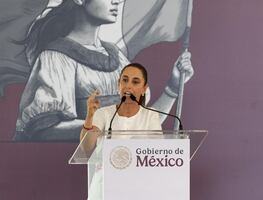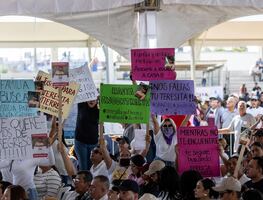Más Información

Jóvenes mexicanos pasan más de 2 mil horas al año en el teléfono; OCDE alerta sobre su impacto en la salud mental

Sergio Gutiérrez Luna destaca aprobación de 25 reformas en la 66 Legislatura; "Un logro histórico para la 4T", señala

Secretario de Agricultura reafirma defensa del maíz blanco; "Seguiremos apoyando la producción nacional no transgénica", afirma

¿Maíz transgénero? Rubén Rocha corrige desliz durante discurso en Sinaloa; destaca importancia del maíz blanco

Sheinbaum asegura apoyo total a Sinaloa para enfrentar violencia; "Nunca los vamos a dejar solos, aquí está la presidenta"

Dictan 600 años de prisión a "El Negro" Radilla y "El Cone"; responsables de secuestrar al hijo de Javier Sicilia
Nearly 80 km from Mérida is the Puuc Route, a region with several Mayan archeological ruins with a very ornamented architectural style, scattered between southern Yucatán and northern Campeche .
Inside the route
In this place, you will find the archeological sites of Uxmal , Kabah , Sayil , Xlapal , Oxkintok , Labná , and the Loltún Caves , whose splendor was on the Late Classic period (900-1000 A.D.)
Have you heard of
?
Meaning
Puuc means “ hill ” or “ highland ,” in Mayan language .
How to recognize the Puuc style
It is one of the seven Mayan architectonic styles . Identify it by its cresting, false and rounded columns, the Chaac masks , stones assembled like mosaics, hand-carved decorative elements in stones, among other characteristics.
Loltún means “ stone flower .” These underground caves are located 100 km away from Mérida. Evidence of human presence of 7,000 years of age, cave paintings, Mayan sculptures, and utensils, as well as mammoth and other animals skulls , have been found in them. In the end, you will be able to see a big collapsed vault. It is mandatory to visit it with a guide. The journey is 1 km long and lasts for approximately two hours. The schedules are set. They close at 16:00 , so arrive early. Entrance fee: MXN $109.

It means “ The Lord of the powerful hand .” Some of its fronts were carefully decorated, such as the Palace of Masks , with 250 large masks of god Chaac . It connects to Uxmal through a sacbé (a white road) that begins, it is said, in the famous arch where all tourists want a picture. This is, no doubt, one of the most beautiful archeological site in Yucatán. Entrance fee: MXN $50.

“ Old or abandoned house ”. Its most outstanding construction is the Arch . You can also visit a palace and an observatory . It is located 49 km away from Uxmal.
Have you heard archeologists discovered a
?
It means “ old walls .” The palace still has a board on its front with stone mosaics and other geometrical elements. It is located between Sayil and Labná . The entrance is free .

“ The place of the ants .” Its most famous features are the rounded columns and the fronts decorated with stone mosaics. The most important building is The Palace , with 90 chambers that, it is believed, could have been home to 350 persons. It is 25 km away from Uxmal. Entrance fee: MXN $50.

In Maya, it means “ the three-suns rock .” Here, you will see The Labyrinth , a sculpted rock that represents the journey to the Mayan underworld.
Did you know the
has met the digital world?

This site declared World Heritage in 1996 is located 80 km from Mérida. It is usually the last stop in the Puuc Route . It is the biggest and most representative site due to its variety of buildings and decorations although it might also be the one with the most restorations.
Its structures preserve the Chaac masks , panels with glyphs, and cresting.
Have you heard of
the environmental impact of the Maya civilization
?
It was built between the years 700 and 1000 (A.D.) . There are least four structures you cannot miss: the Pyramid of the Magician (Uxmal’s iconic construction), the Palace of the Governor , The Temple of the Doves, and the Quadrangle of the Nuns . Entrance fee: MXN $176 (bring and ID that shows your Mexican nationality) Foreigners pay MXN $416.

How to travel in the Puuc Route
There are three options:
- Rent a car
- Take a bus in Merica that makes stops in the archeological sites until it completes the route (it leaves at 8:00 and returns at 16:00; it costs MXN $178 and departs from the TAME station)
- Hire the services of a tour operator like Mayan Heritage and Mayan Ecotours
The last option is the most recommended if you want to get to know deeper the history of the ceremonial sites , their cosmogony , and architecture .
Have you heard of
?
mp




